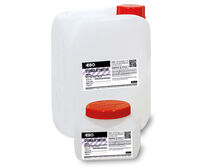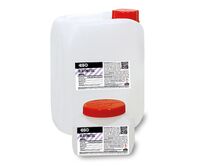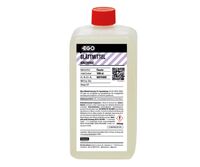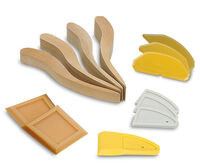EGO SMOOTHING AGENTS
Smoothing agents are used for re-smoothing freshly injected sealant surfaces such as silicone, SMP, PUR, acrylic, etc.
SILICONE SMOOTHING AGENT
If silicone joints have to be made, it is very important to ensure smooth surfaces on the joints. In this way, you prevent dirt or mould from settling there. For an optimally smooth joint, there are ready-to-use smoothing agents for joint sealants. Please note the compatibility of your smoothing agent with the sealant used, e.g. silicone as well as with the substrate. EGO smoothing agents are tested and approved with EGO sealants, otherwise we recommend that you carry out your own tests before use.
THE EGO SMOOTHING AGENT TYPES
- Gentle smoothing agent for silicone, MS Polymer, polyurethane and acrylic sealants
- (Either as concentrate 3 caps to one litre of clean water, or standard (for Smoothing agent standard) dilute with clean water in a ratio of 1:4 to a maximum of 1:5)
- Special Smoothing agent for marble and natural stone
EGO tip:
All EGO smoothing agents must always be used fresh (avoid contamination with sealant) and use sparingly. Remove excess EGO smoothing agent immediately and do not let it dry!
Adjacent surfaces (e.g. oak veneered doors, natural stones, rough materials) are often prone to discolouration by liquids and must be protected when applying smoothing agents.
SMOOTH JOINT CREATION WITH EGO SMOOTHING AGENT
With silicone joints, it is important to ensure smooth surfaces so that no dirt can adhere afterwards. The easiest way to do this is with EGO's ready-to-use smoothing agent for joint sealants.
You benefit from several factors when using a silicone smoothing agent: On one hand, the appearance of your joints improves. On the other hand, a smoothing agent promotes faster hardening of the silicone sealant. By smoothing the surface, the joint becomes more resistant to dirt and mould, which in turn makes the everyday care and cleaning of your joints much easier. The smoothing agent must be applied before skin formation occurs on the silicone joint. Make sure the surface is clean and smooth. For this purpose it is best to use a special Smoothing trowel, which you can also find in our shop.
EGO tip:
Ideally, apply your joint in one piece and smooth immediately after applying. This ensures that the sealant has not yet formed a skin and gives you the opportunity to smooth your joint perfectly. A section-by-section approach makes the most sense for a clean work result!
INSTRUCTIONS FOR SMOOTHING JOINTS
After applying the joint comes the most difficult part – smoothing the silicone joint! Many an experienced craftsman has despaired of the strong adhesive properties of silicone. In spite of a trowel and good silicone, it is often difficult to produce a smooth surface.
To achieve an optimal result, you must apply the silicone smoothing agent to the silicone joints. We do not recommend using a spray bottle. Use the smoothing agent sparingly, possibly even with a brush.
After this preparation, the joint material is ready to be smoothed. There is often controversy about the best tool for smoothing: A professional trowel, a simple spoon or even lolly sticks can be used for smoothing. Finally, the respective tool is pulled along the joint and wiped with the finger. But be careful: Smoothing with the bare finger without tools is very difficult and not recommended!
For a professional and long-lasting result, the joint should be smoothed in one go. Further attempts at correction afterwards are usually clearly visible.
EGO tip:
Afterwards, you should not touch your joints according to the application instructions for hardening. Pay attention to the times given and the ambient temperatures to which they refer. Further useful instructions can usually be found on the packaging or on the grout cartridge itself.
Frequently asked questions
Smoothing agents are used for re-smoothing freshly injected sealant surfaces such as silicone, SMP, PUR, acrylic, etc. The silicone smoothing agents simplify the smoothing process, thus preventing the formation of dirt and mould.
You need “soft water” to flatten sealants. Washing-up liquid has the task of cleaning, so it often contains fat-dissolving substances as well as fragrances. These are substances which are not necessary during smoothing and these may have negative effects on the grouting.
Under certain circumstances, this may result in a chemical incompatibility with the sealant used. Although the person applying it sees good smoothing behaviour and “feels” a compacted surface, when you look in more detail, the surface of the joint is attacked by the agent. Small “imperfections” are created. Under certain circumstances, yellowish or matt stains may appear on the sealants. The then “rough” surface is no longer optimally resistant to mould, cleaning agents etc. and can become dirty more quickly. Especially in damp rooms, there is an increased danger here, as organic residues contained in washing-up liquid can also serve as a food source for mould! Furthermore, streaking may occur due to abrasion during subsequent cleaning. A film of washing-up liquid on the joint not only reduces the sealant’s freedom of movement (similar to a coat of paint), in addition, the incompatible film can cause a type of corrosion to set in, the joint can age prematurely in terms of chemical composition and surface cracks can develop. These cracks are “predetermined breaking points”, in a way, and get progressively worse where movements occur.
This is why we recommend using EGO smoothing agent or EGO stone smoothing agent. They have the following advantages over conventional soapy water:
- Minimised risk of staining or yellowing on the sealants
- Better skin tolerance due to substances from baby cosmetics
- Higher protection against mould, abrasion and ageing
- No leaching of colour pigments from the silicones
- Less silicone leaching in the smoothing agent
We offer various smoothing agents to match the sealant you are using. You can also choose between different concentrations: We offer our “Gentle smoothing agent for silicone, SMP/MS Polymer, polyurethane and acrylic sealants” in the standard version (mixing ratio 1:4 to max. 1:5) or as a concentrate (mixing ratio 1:100). With the special smoothing agent for marble and natural stone, the EGO Steinglättmitel, you can smooth natural stone silicone and surface-textured silicone.
Of course, you can grout your joints with silicone smoothing agent on your own. With conscientious implementation of the work steps and a little practice, you will succeed in creating optimal and long-lasting joints. Equip yourself with silicone, trowel and the silicone smoothing agent and say goodbye to mould and dirt on your joints!
A smooth surface is crucial for clean silicone joints. Work your way forward step by step and smooth the respective joint directly after application. After application with silicone smoothing agent, everything goes very quickly: With tools such as trowels or wooden sticks, carefully pull off one joint after the other and you have your smooth joints!



